Comparing Reflectivity from Space-Based and Ground-Based Radars During Detection of Rainbands in Two Tropical Cyclones
Abstract
1. Introduction
2. Materials and Methods
2.1. Materials
2.1.1. TC-Specific Information
2.1.2. Data from the Ground Validation Network
2.1.3. Mosaic Datasets
2.2. Methods
2.2.1. Mosaic Creation and Extraction of Points
2.2.2. Statistical Testing
3. Results
3.1. Distributions of Values and Errors
3.2. Friedman Tests and Post-Hoc Dunn’s Tests
3.3. Comparisons Between DPR and GR
3.4. Results for MAX Mosaic
3.5. Trends in Difference Values According to DPR Reflectivity
3.6. Exploring Time Offsets
4. Conclusions
Author Contributions
Funding
Data Availability Statement
Acknowledgments
Conflicts of Interest
References
- Crum, T.D.; Alberty, R.L. The WSR-88D and the WSR-88D operational support facility. Bull. Am. Meteor. Soc. 1993, 74, 1669–1688. [Google Scholar] [CrossRef]
- Lakshmanan, V.; Smith, T.; Hondl, K.; Stumpf, G.J.; Witt, A. A real-time, three-dimensional, rapidly updating, heterogeneous radar merger technique for reflectivity, velocity, and derived products. Weather. Forecast. 2006, 21, 802–823. [Google Scholar] [CrossRef]
- Melnikov, V.M.; Zrnić, D.S.; Doviak, R.J.; Chilson, P.B.; Mechem, D.B.; Kogan, Y.L. Prospects of the WSR-88D radar for cloud studies. J. Appl. Meteorol. Climatol. 2011, 50, 859–872. [Google Scholar]
- Ryzhkov, A.; Zrnic, D.S. Precipitation and attenuation measurements at a 10-Cm wavelength. J. Appl. Meteor. 1995, 34, 2121–2134. [Google Scholar] [CrossRef]
- Mancini, A.; Lebrón, R.M.; Salazar, J.L. The Impact of a wet S-Band radome on dual-polarized phased-array radar system performance. IEEE Trans. Antennas Propag. 2018, 67, 207–220. [Google Scholar] [CrossRef]
- Parry, C.; Fenn, A.J.; Morris, A.; Thomas, H. Analysis and mitigation of the reflected power on an S-band planar phased array antenna transmitting in a wet spherical radome. In Proceedings of the 2022 IEEE International Symposium on Phased Array Systems & Technology (PAST), Waltham, MA, USA, 11–14 October 2022; pp. 1–7. [Google Scholar]
- Smith, J.A.; Seo, D.J.; Baeck, M.L.; Hudlow, M.D. An intercomparison study of NEXRAD precipitation estimates. Water Resour. Res. 1996, 32, 2035–2045. [Google Scholar]
- Ulbrich, C.W.; Lee, L.G. Rainfall measurement error by WSR-88d radars due to variations in Z-R law parameters and the radar constant. J. Atmos. Ocean. Technol. 1999, 16, 1017–1024. [Google Scholar]
- Matyas, C.J. Use of ground-based radar for climate-scale studies of weather and rainfall. Geogr. Compass 2010, 4, 1218–1237. [Google Scholar]
- Schwaller, M.; Morris, K. Satellite observations for calibration of ground radar networks. In Proceedings of the AGU Fall Meeting Abstracts, San Francisco, CA, USA, 5–9 December 2011. H41G-1135. [Google Scholar]
- Biswas, S.K.; Chandrasekar, V. Cross-validation of observations between the GPM dual-frequency precipitation radar and ground based dual-polarization radars. Remote Sens. 2018, 10, 1773. [Google Scholar] [CrossRef]
- Matyas, C.J.; Zick, S.E.; Tang, J. Using an object-based approach to quantify the spatial structure of reflectivity regions in Hurricane Isabel (2003): Part I: Comparisons between radar observations and model simulations. Mon. Wea. Rev. 2018, 146, 1319–1340. [Google Scholar] [CrossRef]
- Matyas, C.; Tang, J. Measuring radial and tangential changes in tropical cyclone rain fields using metrics of dispersion and closure. Adv. Meteorol. 2019, 2019, 8613943. [Google Scholar] [CrossRef]
- Sun, M.; Wang, H.; Li, Z.; Gao, M.; Xu, Z.; Li, J. Study on reflectivity data interpolation and mosaics for multiple Doppler weather radars. EURASIP J. Wirel. Commun. Netw. 2019, 2019, 145. [Google Scholar] [CrossRef]
- Brook, J.P.; Protat, A.; Soderholm, J.S.; Warren, R.A.; McGowan, H. A variational interpolation method for gridding weather radar data. J. Atmos. Ocean. Technol. 2022, 39, 1633–1654. [Google Scholar] [CrossRef]
- Yuter, S.E.; Houze, R.A. Three-Dimensional kinematic and microphysical evolution of Florida cumulonimbus. Part I: Spatial distribution of updrafts, downdrafts, and precipitation. Mon. Wea. Rev. 1995, 123, 1921–1940. [Google Scholar] [CrossRef]
- Langston, C.; Zhang, J.; Howard, K. Four-Dimensional dynamic radar mosaic. J. Atmos. Ocean. Technol. 2007, 24, 776–790. [Google Scholar] [CrossRef]
- Zhang, J.; Howard, K.; Gourley, J.J. Constructing three-dimensional multiple-radar reflectivity mosaics: Examples of convective storms and stratiform rain echoes. J. Atmos. Ocean. Technol. 2005, 22, 30–42. [Google Scholar] [CrossRef]
- OFCM. Federal Meteorological Handbook, No. 11: WSR-88D Meteorological Observations. In Part C WSR-88D Products and Algorithms; Office of the Federal Coordinator for Meteorological Services and Supporting Research, Ed.; U.S. Department of Commerce/NOAA: Silver Spring, MD, USA, 2017. [Google Scholar]
- Kingfield, D.M.; French, M.M. The influence of WSR-88D intra-volume scanning strategies on thunderstorm observations and warnings in the dual-polarization radar era: 2011–20. Weather. Forecast. 2022, 37, 283–301. [Google Scholar] [CrossRef]
- Matyas, C.J. Associations between the size of hurricane rain fields at landfall and their surrounding environments. Meteorol. Atmos. Phys. 2010, 106, 135–148. [Google Scholar] [CrossRef]
- Willoughby, H.E.; Marks, F.D.; Feinberg, R.J. Stationary and moving convective bands in hurricanes. J. Atmos. Sci. 1984, 41, 3189–3211. [Google Scholar] [CrossRef]
- Anagnostou, E.N.; Morales, C.A.; Dinku, T. The use of TRMM precipitation radar observations in determining ground radar calibration biases. J. Atmos. Ocean. Technol. 2001, 18, 616–628. [Google Scholar] [CrossRef]
- Li, Z.; Wen, Y.; Liao, L.; Wolff, D.; Meneghini, R.; Schuur, T. Joint collaboration on comparing NOAA’s ground-based weather radar and NASA–JAXA’s spaceborne radar. Bull. Amer. Meteor. Soc. 2023, 104, E1435–E1451. [Google Scholar] [CrossRef]
- Schwaller, M.R.; Morris, K.R. A ground validation network for the global precipitation measurement mission. J. Atmos. Ocean. Technol. 2011, 28, 301–319. [Google Scholar] [CrossRef]
- Warren, R.A.; Protat, A.; Siems, S.T.; Ramsay, H.A.; Louf, V.; Manton, M.J.; Kane, T.A. Calibrating ground-based radars against TRMM and GPM. J. Atmos. Ocean. Technol. 2018, 35, 323–346. [Google Scholar] [CrossRef]
- Masaki, T.; Iguchi, T.; Kanemaru, K.; Furukawa, K.; Yoshida, N.; Kubota, T.; Oki, R. Calibration of the Dual-Frequency Precipitation Radar Onboard the Global Precipitation Measurement Core Observatory. IEEE Trans. Geosci. Remote Sens. 2020, 60, 5100116. [Google Scholar] [CrossRef]
- Keem, M.; Seo, B.-C.; Krajewski, W.F.; Morris, K.R. Inter-comparison of reflectivity measurements between GPM DPR and NEXRAD radars. Atmos. Res. 2019, 226, 49–65. [Google Scholar] [CrossRef]
- Knapp, K.R.; Diamond, H.J.; Kossin, J.P.; Kruk, M.C.; Schreck, C.J.I. International Best Track Archive for Climate Stewardship (IBTrACS); National Centers for Environmental Information: Asheville, NC, USA, 2018. [CrossRef]
- National Hurricane Center Tropical Cyclone Report: Hurricane Laura. National Hurricane Center, 2021. Available online: https://www.nhc.noaa.gov/data/tcr/AL132020_Laura.pdf (accessed on 28 November 2024).
- National Hurricane Center Tropical Cyclone Report: Hurricane Isaias. National Hurricane Center, 2021. Available online: https://www.nhc.noaa.gov/data/tcr/AL092020_Isaias.pdf (accessed on 30 November 2024).
- Skofronick-Jackson, G.; Berg, W.; Kidd, C.; Kirschbaum, D.B.; Petersen, W.A.; Huffman, G.J.; Takayabu, Y.N. Global Precipitation Measurement (GPM): Unified precipitation estimation from space. In Remote Sensing of Clouds and Precipitation; Andronache, C., Ed.; Springer International Publishing: Cham, Switzerland, 2018; pp. 175–193. [Google Scholar] [CrossRef]
- NASA/JAXA. Precipitation Measurement Missions: Global Precipitation Mission (GPM) Ground Validation System. 2015. Available online: https://gpm.nasa.gov/sites/default/files/document_files/Val_Network_Users_Guide_Vol_2_Nov2015.pdf (accessed on 25 October 2024).
- Iguchi, T.; Seto, S.; Meneghini, R.; Yoshida, N.; Awaka, J.; Le, M.; Chandrasekar, V.; Kubota, T. GPM/DPR Level-2 Algorithm Theoretical Basis Document; NASA Goddard Space Flight Center: Greenbelt, MD, USA, 2010. [Google Scholar]
- Lakshmanan, V.; Humphrey, T.W. A MapReduce technique to mosaic continental-scale weather radar data in real-time. IEEE J. Sel. Top. Appl. Earth Obs. Remote Sens. 2014, 7, 721–732. [Google Scholar] [CrossRef]
- Tang, J.; Matyas, C.J. High efficiency weather radar mosaic image generation framework. In Proceedings of the 2021 IEEE International Geoscience and Remote Sensing Symposium IGARSS, Brussels, Belgium, 11–16 July 2021; pp. 367–369. [Google Scholar]
- Tang, J.; Matyas, C.J. Fast playback framework for analysis of ground-based Doppler radar observations using Map-Reduce technology. J. Atmos. Ocean. Technol. 2016, 33, 621–634. [Google Scholar] [CrossRef]
- Wilks, D.S. Statistical Methods in the Atmospheric Sciences; Academic Press: San Diego, CA, USA, 1995; p. 467. [Google Scholar]
- Friedman, M. The use of ranks to avoid the assumption of normality implicit in the analysis of variance. J. Am. Stat. Assoc. 1937, 32, 675–701. [Google Scholar] [CrossRef]
- Keselman, H.; Algina, J.; Kowalchuk, R.K. The analysis of repeated measures designs: A review. Br. J. Math. Stat. Psychol. 2001, 54, 1–20. [Google Scholar] [CrossRef]
- Pereira, D.G.; Afonso, A.; Medeiros, F.M. Overview of Friedman’s test and post-hoc analysis. Commun. Stat.-Simul. Comput. 2015, 44, 2636–2653. [Google Scholar] [CrossRef]
- Dunn, O.J. Multiple comparisons among means. J. Am. Stat. Assoc. 1961, 56, 52–64. [Google Scholar] [CrossRef]
- Cabin, R.J.; Mitchell, R.J. To Bonferroni or not to Bonferroni: When and how are the questions. Bull. Ecol. Soc. Am. 2000, 81, 246–248. [Google Scholar]
- Liao, L.; Meneghini, R. GPM DPR retrievals: Algorithm, evaluation, and validation. Remote Sens. 2022, 14, 843. [Google Scholar] [CrossRef]
- Jonckheere, A.R. A distribution-free k-sample test against ordered alternatives. Biometrika 1954, 41, 133–145. [Google Scholar] [CrossRef]
- Brauer, N.S.; Alford, A.A.; Waugh, S.M.; Biggerstaff, M.I.; Carrie, G.D.; Kirstetter, P.E.; Basara, J.B.; Dawson, D.T.; Elmore, K.L.; Stevenson, J. Hurricane Laura (2020): A comparison of drop size distribution moments using ground and radar remote sensing retrieval methods. J. Geophys. Res. Atmos. 2022, 127, e2021JD035845. [Google Scholar] [CrossRef]
- Stackhouse, S.D.; Zick, S.E.; Matyas, C.J.; Wood, K.M.; Hazelton, A.T.; Alaka Jr, G.J. Evaluation of experimental high-resolution model forecasts of tropical cyclone precipitation using object-based metrics. Weather. Forecast. 2023, 38, 2111–2134. [Google Scholar] [CrossRef]
- Zick, S.E.; Matyas, C.J. A shape metric methodology for studying the evolving geometries of synoptic-scale precipitation patterns in tropical cyclones. Ann. Assoc. Am. Geogr. 2016, 106, 1217–1235. [Google Scholar] [CrossRef]
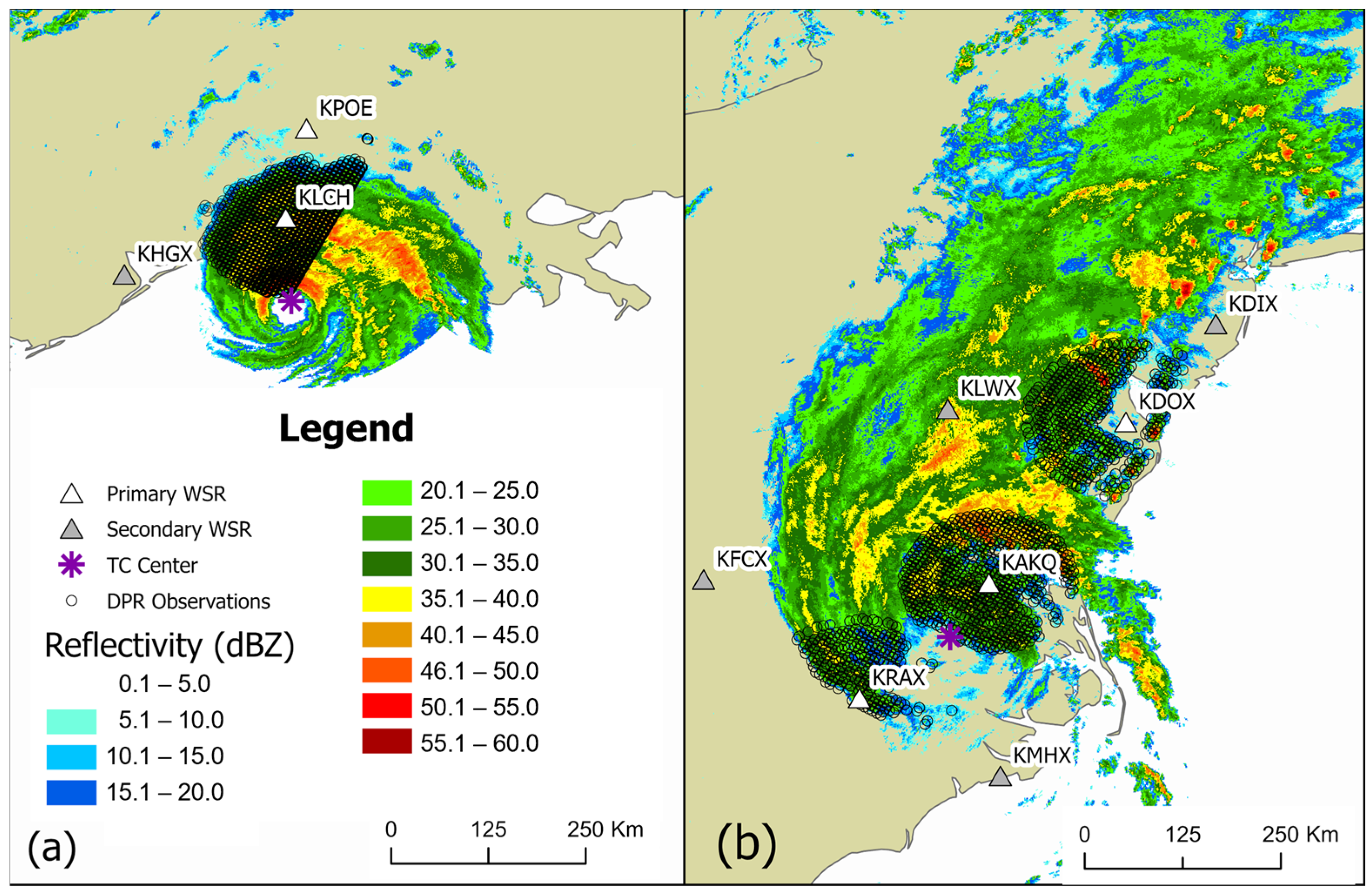

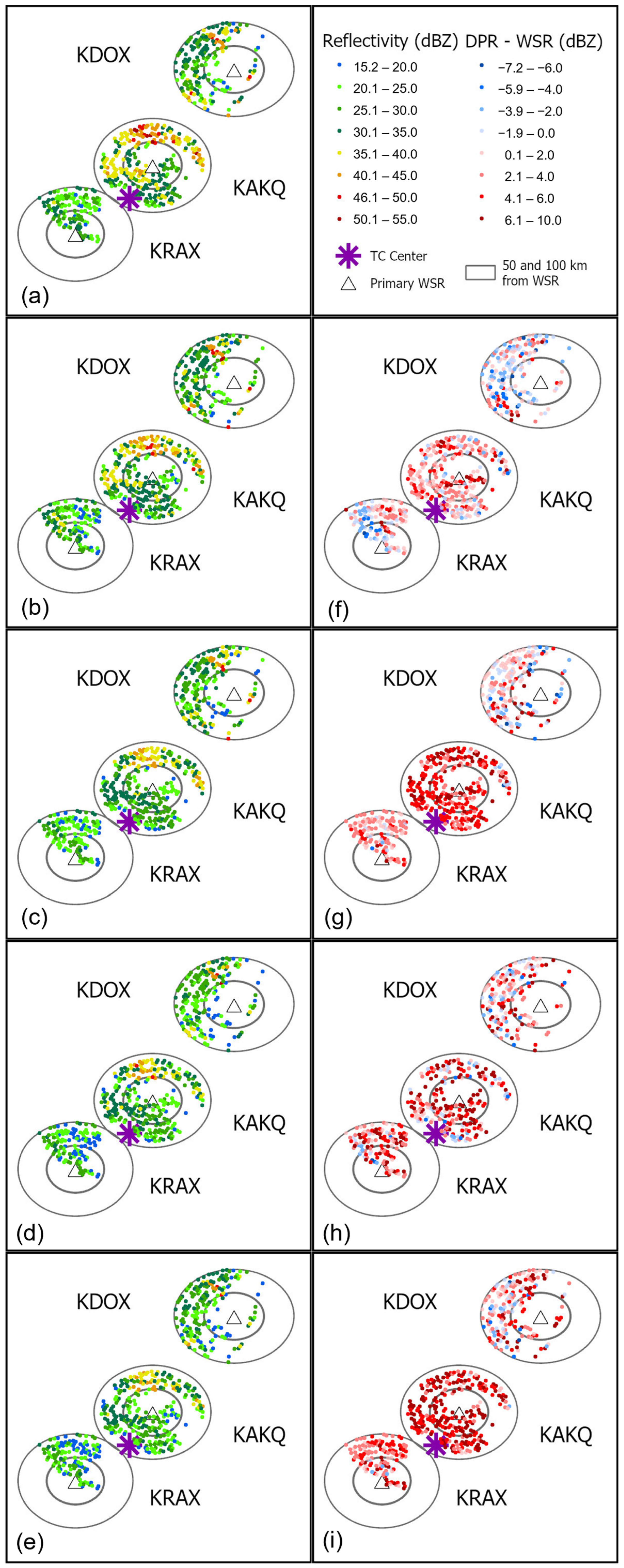

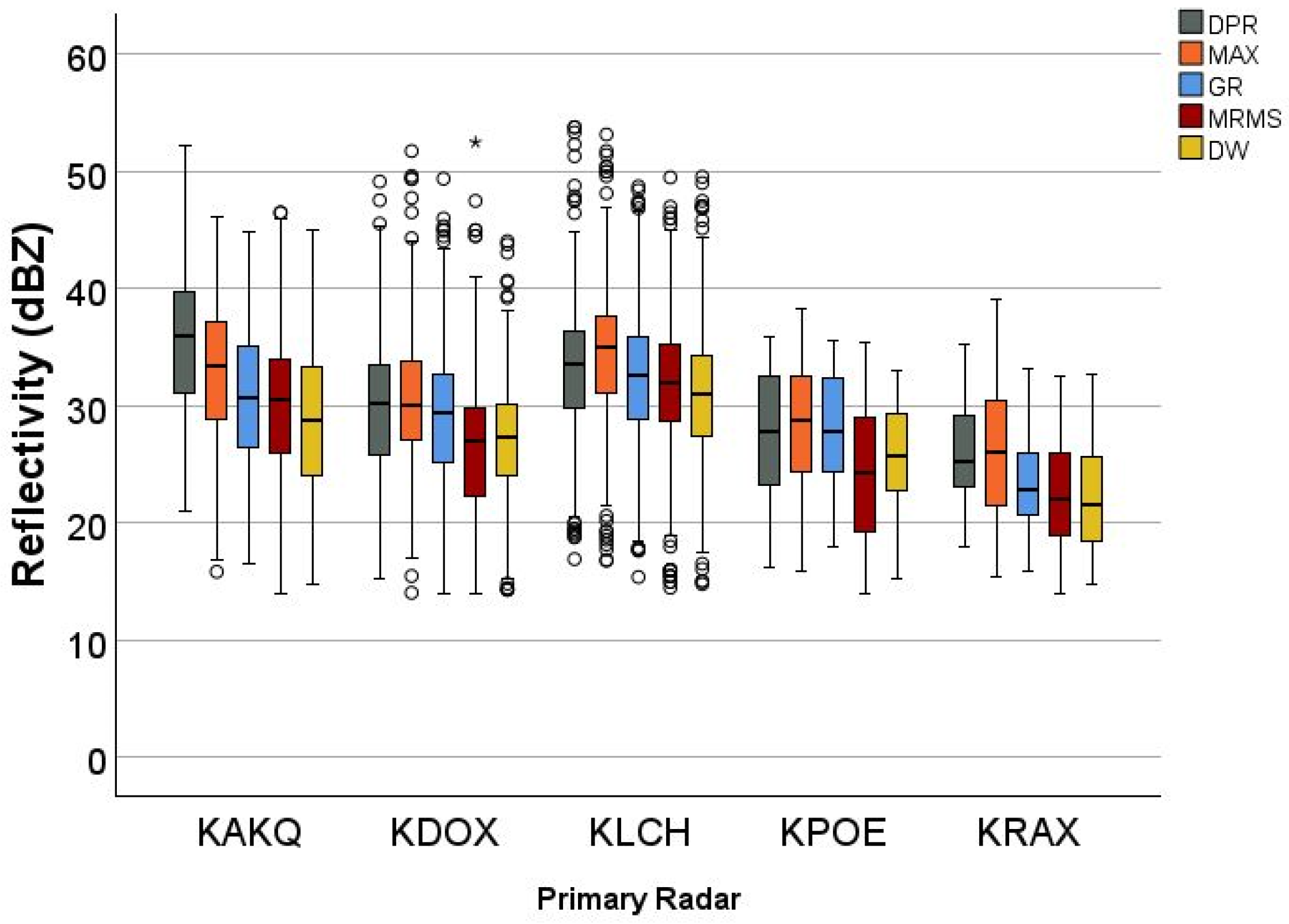
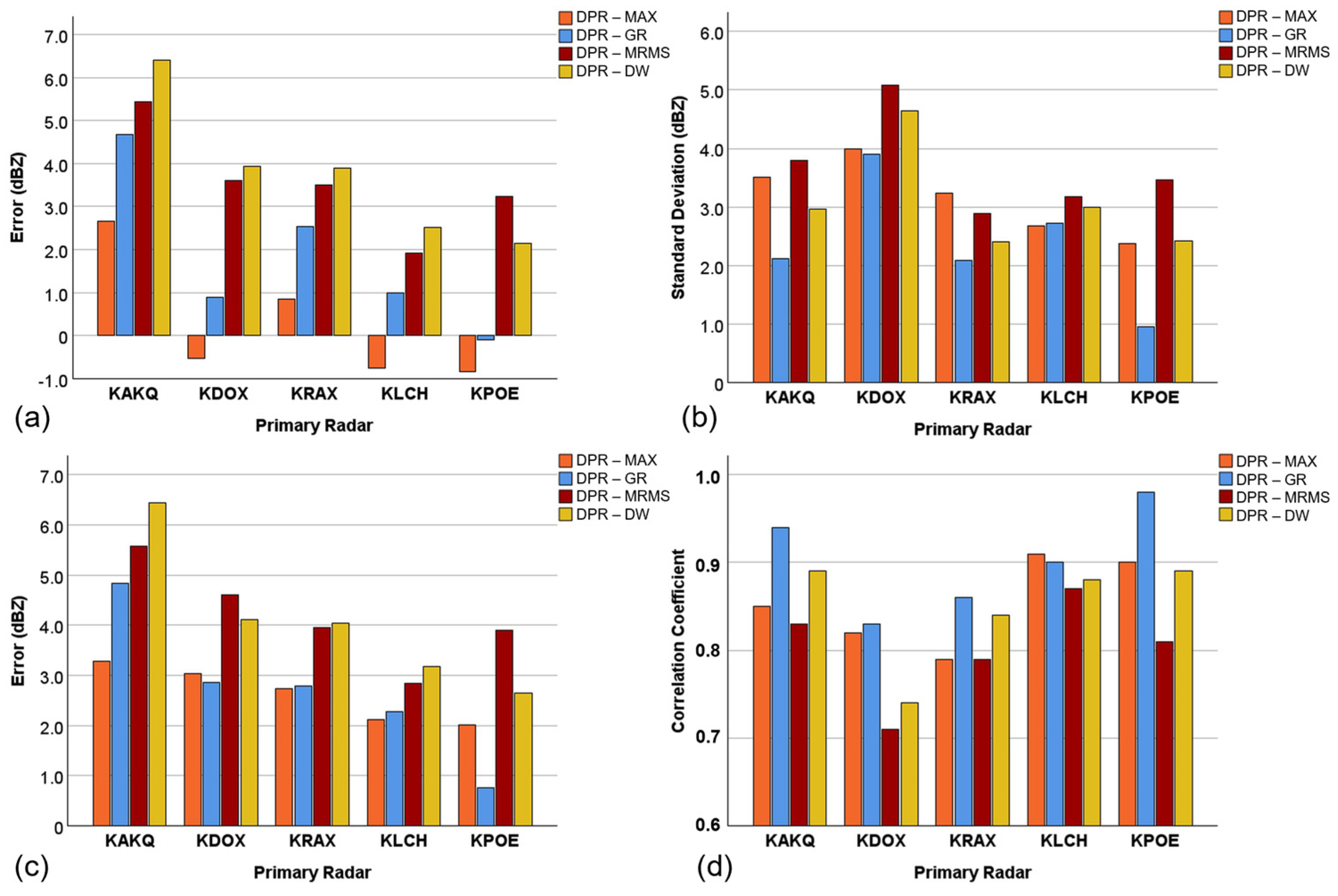

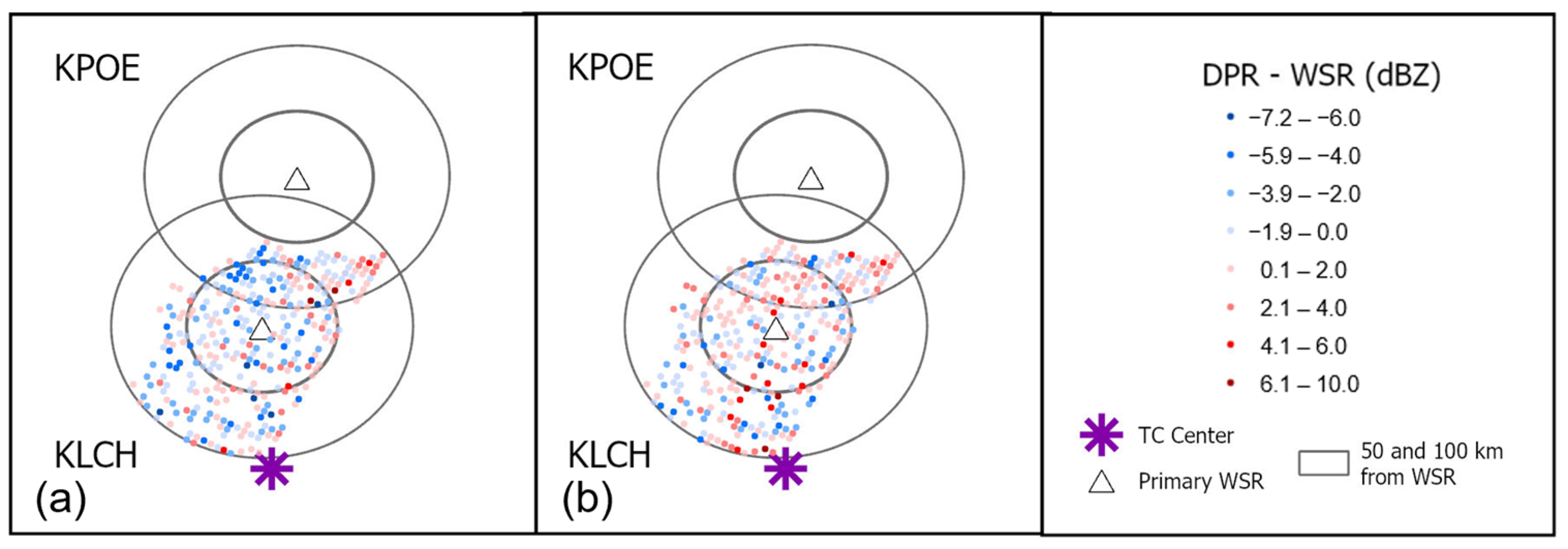
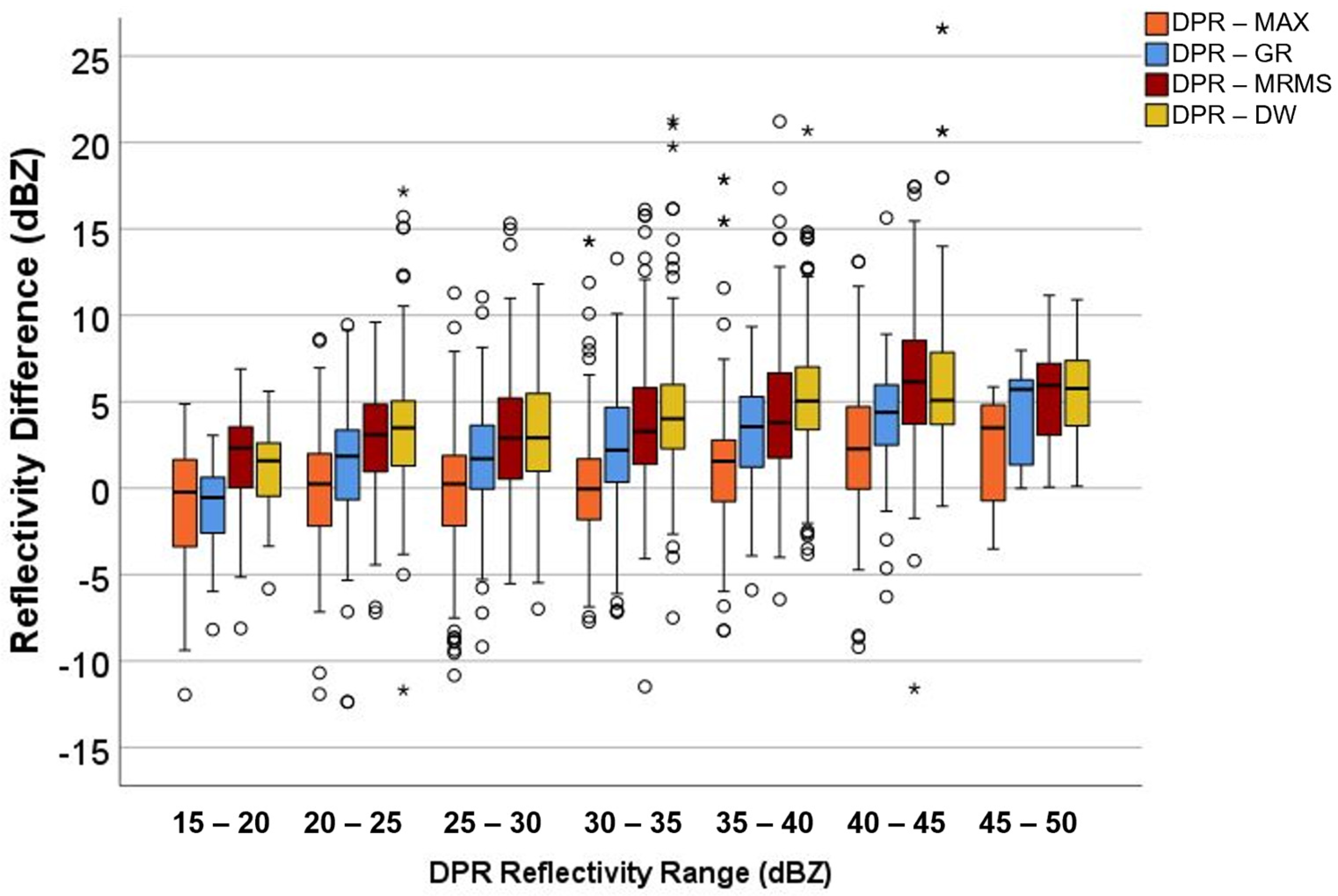
| Sampling Method | Acronym | Data Source | Geometry | How Samples Are Created |
|---|---|---|---|---|
| Dual-frequency Precipitation Radar | DPR | Global Precipitation Measurement (GPM) mission Ground Validation Archive | Points | NASA matches DPR rays and WSR-88D beams in 4D within 100 km of one of 92 GRs |
| Ground Radar | GR | GPM Ground Validation Archive | Points | NASA averages WSR-88D beams under DPR footprint |
| Multi-Radar/ Multi-Sensor | MRMS | Iowa State IEM website | 1 × 1 km grid | Reflectivity mosaic from WSR-88D and Terminal Doppler Weather Radars created by NSSL |
| Maximum | MAX | Amazon Web Service (AWS) WSR-88D Level II archives | 1 × 1 km grid | We create a mosaic from Level II data that preserves the highest reflectivity in a grid cell |
| Distance Weight | DW | AWS WSR-88D Level II archives | 1 × 1 km grid | We create a mosaic from Level II data that averages reflectivity in a cell after applying weights according to distance from radar |
| Radar | TC | VCP | VCP start Time (UTC) | VCP Duration (HH:MM:SS) | Time DPR Closest to Radar (UTC) | Distance to TC Center (km) | Rain on WSR | Reflectivity Distance from Radar (km) |
|---|---|---|---|---|---|---|---|---|
| KAKQ * | Isaias | 212 | 08:48:47 | 0:07:26 | 08:52:58 | 86 | Yes | 0–100 |
| KDIX | Isaias | 212 | 08:49:39 | 0:05:33 | 08:53:55 | 476 | No | 65–220 |
| KDOX * | Isaias | 212 | 08:53:05 | 0:06:14 | 08:53:33 | 335 | No | 30–100 |
| KFCX | Isaias | 212 | 08:51:01 | 0:05:12 | 08:52:37 | 260 | No | 120–180 |
| KLWX | Isaias | 212 | 08:49:00 | 0:06:40 | 08:53:21 | 290 | Yes | 80–215 |
| KMHX | Isaias | 212 | 08:53:09 | 0:05:52 | 08:52:29 | 185 | No | 130–220 |
| KRAX * | Isaias | 212 | 08:50:32 | 0:07:25 | 08:52:30 | 117 | Yes | 0–100 |
| KHGX | Laura | 212 | 02:57:51 | 0:04:48 | 03:00:22 | 191 | No | 100–220 |
| KLCH * | Laura | 215 | 02:59:57 | 0:06:43 | 03:00:43 | 111 | Yes | 0–100 |
| KPOE * | Laura | 212 | 02:58:48 | 0:06:07 | 03:00:59 | 222 | No | 50–100 |
| Radar | N | Chi-Square | p Value |
|---|---|---|---|
| KAKQ | 350 | 779.2 | <0.001 |
| KDOX | 188 | 247.5 | <0.001 |
| KRAX | 131 | 247.6 | <0.001 |
| KLCH | 255 | 335.9 | <0.001 |
| KPOE | 84 | 135.3 | <0.001 |
| KAKQ | KDOX | KRAX | KLCH | KPOE | |
|---|---|---|---|---|---|
| DPR | 4.67 | 3.78 | 4.31 | 3.73 | 3.55 |
| MAX | 3.69 | 3.85 | 3.95 | 4.05 | 4.02 |
| GR | 2.5 | 3.28 | 2.69 | 2.96 | 3.58 |
| MRMS | 2.43 | 2.21 | 2.28 | 2.38 | 1.83 |
| DW | 1.69 | 1.88 | 1.77 | 1.87 | 2.01 |
| Radar | KAKQ | KDOX | KRAX | KLCH | KPOE |
|---|---|---|---|---|---|
| DPR vs. MAX | <0.001 | 0.672 | 0.066 | 0.019 | 0.051 |
| DPR vs. GR | <0.001 | 0.002 | <0.001 | <0.001 | 0.884 |
| DPR vs. MRMS | <0.001 | <0.001 | <0.001 | <0.001 | <0.001 |
| DPR vs. DW | <0.001 | <0.001 | <0.001 | <0.001 | <0.001 |
| GR vs. MAX | <0.001 | <0.001 | <0.001 | <0.001 | 0.071 |
| GR vs. MRMS | 0.451 | <0.001 | 0.035 | <0.001 | <0.001 |
| MAX vs. MRMS | <0.001 | <0.001 | <0.001 | <0.001 | <0.001 |
| MRMS vs. DW | <0.001 | 0.047 | 0.009 | <0.001 | 0.464 |
| GR vs. DW | <0.001 | <0.001 | <0.001 | <0.001 | <0.001 |
| MAX vs. DW | <0.001 | <0.001 | <0.001 | <0.001 | <0.001 |
| 15–50 dBZ Standardized Test Statistic | 15–50 dBZ p Value | 15–35 dBZ Standardized Test Statistic | 15–35 dBZ p Value | |
|---|---|---|---|---|
| DPR-MAX | 6.832 | <0.001 | 0.616 | 0.538 |
| DPR-GR | 10.537 | <0.001 | 5.250 | <0.001 |
| DPR-MRMS | 7.236 | <0.001 | 2.912 | 0.004 |
| DPR-DW | 9.853 | <0.001 | 4.565 | <0.001 |
| Time 1 and Time 2 (UTC) | Time Offset (min) | KLCH p Value | KPOE p Value |
|---|---|---|---|
| 0256 and 0258 | 2 | 0.127 | 0.027 |
| 0258 and 0300 | 2 | 0.218 | 0.380 |
| 0300 and 0302 | 2 | 0.547 | 0.733 |
| 0302 and 0304 | 2 | 0.538 | 0.034 |
| 0256 and 0300 | 4 | 0.006 | 0.001 |
| 0258 and 0302 | 4 | 0.067 | 0.223 |
| 0300 and 0304 | 4 | 0.223 | 0.014 |
| 0256 and 0302 | 6 | 0.001 | 0.000 |
| 0258 and 0304 | 6 | 0.001 | 0.001 |
| 0256 and 0304 | 8 | 0.000 | 0.000 |
Disclaimer/Publisher’s Note: The statements, opinions and data contained in all publications are solely those of the individual author(s) and contributor(s) and not of MDPI and/or the editor(s). MDPI and/or the editor(s) disclaim responsibility for any injury to people or property resulting from any ideas, methods, instructions or products referred to in the content. |
© 2025 by the authors. Licensee MDPI, Basel, Switzerland. This article is an open access article distributed under the terms and conditions of the Creative Commons Attribution (CC BY) license (https://creativecommons.org/licenses/by/4.0/).
Share and Cite
Matyas, C.J.; Zick, S.E.; Wood, K.M. Comparing Reflectivity from Space-Based and Ground-Based Radars During Detection of Rainbands in Two Tropical Cyclones. Atmosphere 2025, 16, 307. https://doi.org/10.3390/atmos16030307
Matyas CJ, Zick SE, Wood KM. Comparing Reflectivity from Space-Based and Ground-Based Radars During Detection of Rainbands in Two Tropical Cyclones. Atmosphere. 2025; 16(3):307. https://doi.org/10.3390/atmos16030307
Chicago/Turabian StyleMatyas, Corene J., Stephanie E. Zick, and Kimberly M. Wood. 2025. "Comparing Reflectivity from Space-Based and Ground-Based Radars During Detection of Rainbands in Two Tropical Cyclones" Atmosphere 16, no. 3: 307. https://doi.org/10.3390/atmos16030307
APA StyleMatyas, C. J., Zick, S. E., & Wood, K. M. (2025). Comparing Reflectivity from Space-Based and Ground-Based Radars During Detection of Rainbands in Two Tropical Cyclones. Atmosphere, 16(3), 307. https://doi.org/10.3390/atmos16030307








